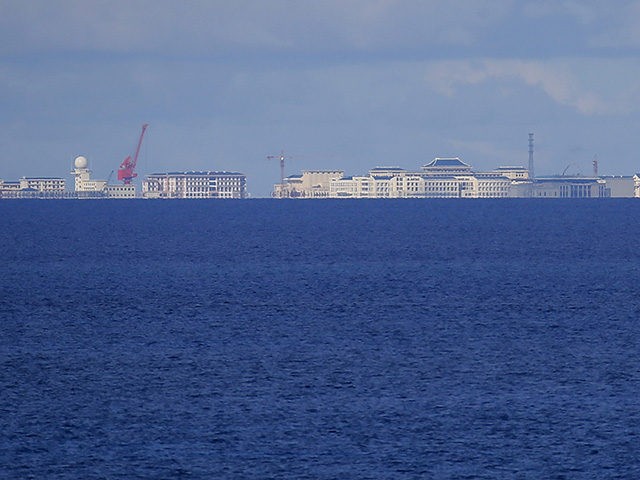China established two new “research stations” in the South China Sea on Yongshu [Fiery Cross Reef] and Zhubi [the Subi Reef], Beijing state news agency Xinhua reported this weekend — evidence China is surging forward with its colonization of the South China Sea while the world grapples with the Chinese coronavirus pandemic.
Billed as scientific research stations, these military installations allegedly aim to study environmental conservation in the area, according to Beijing.
Operating under the Chinese Academy of Sciences’ Integrated Research Center for Islands and Reefs, both stations feature “monitoring systems” for conservation projects, according to Xinhua. The Chinese military has built “several real-time monitoring systems” on Fiery Cross Reef reportedly for coral reef ecosystem, vegetation ecology, and freshwater conservation. The Subi Reef research station reportedly has “completed the project design of monitoring systems” for geological disaster and freshwater conservation. Future research at the stations will focus on “ocean acidification, micro-plastic pollution, coral reef ecosystem conservation and marine disaster treatment.”
The two new stations join the research center’s base at the “Meiji Research Center,” located at Meiji Reef [Panganiban Reef], established in 2018. According to Beijing, the research center aims to “promote innovation capability and the supply of public service products of marine science and technology to meet the needs of both China and other littoral countries around the South China Sea, making contributions to the building of a maritime community with a shared future.”
Fiery Cross Reef and Subi Reef are both disputed territories claimed by Vietnam, the Philippines, and Taiwan. China has seized them and turned the reefs into artificial islands. China illegally claims territory in the South China Sea belonging to those three nations as well as Malaysia and Brunei and has claimed waters off the coasts of Indonesia’s Natuna Island. In January, Indonesia announced increased maritime patrols around islands in the South China Sea shortly after what it viewed as trespassing by Chinese coast guard vessels in Natuna waters.
Commenting on the recent installations, maritime security expert Collin Koh told the Philippines’ Inquirer:
Some may think that the ongoing coronavirus pandemic would have distracted Beijing from these maritime flashpoints … This is far from the case. The PLA (People’s Liberation Army) is touted to remain combat ready despite the coronavirus. Using these supposedly ‘civilian scientific’ endeavors to assert claim is one such modus operandi, and one that’s also often overlooked by all of us. Yet at the same time, the resulting strategic ramifications are not any less insignificant.
The installations serve as the latest example of China’s efforts in recent years to transform reefs and islands in the South China Sea into strategic military outposts. Designed to monitor rival activities and establish an intimidating presence in the contested body of water, the military installations have been known to house communications facilities, airstrips, harbors, and missile shelters.
Rich in oil and natural gas, the South China Sea contains some of the world’s most strategically important maritime territory. According to a 2015 State Department report, $5.3 trillion worth of goods passes through the South China Sea each year, accounting for about 30 percent of global maritime trade.
In recent years, China has exerted increasing control in the South China Sea, claiming zones traditionally considered international territory, or as pertaining to nearby Southeast Asian nations. Many, including the United States, consider the move part of the country’s efforts to transform itself into a major global power. The U.S. has increased its presence in the South China Sea in recent years as well, aiding Southeast Asian nations in their efforts to fight China’s encroachment in the area.
This show of force by the U.S. in the South China Sea has been met with resistance by China, escalating tensions in the area. Earlier in March, Chinese state media suggested the possibility of using an electromagnetic pulse weapon (EMP) against American ships entering the South China Sea.
In 2016, the Permanent Court of Arbitration at the Hague ruled against China in a territorial dispute with the Philippines in the South China Sea. In the landmark trial, the Philippines successfully argued that China had illegally seized its maritime territory. China rejected the 2016 ruling by the international tribunal and continues to assert its claim over almost the entirety of the South China Sea.
According to the 2016 ruling, China broke international law by damaging the marine environment — it dredged up underwater sediment to construct islands large enough to support military installations. This casts doubt on China’s claims that its new research facilities were built for purposes of environmental conservation.
China’s latest show of force in the South China Sea comes amid international condemnation for the communist nation, responsible for the current Chinese coronavirus pandemic, a global crisis ravaging the world’s economy and public health. Authorities have criticized China’s slow response to the coronavirus, originating in Wuhan, China, at the end of last year.
At press time Monday, the Chinese coronavirus had infected 367,457 people and killed 16,097 people globally.

COMMENTS
Please let us know if you're having issues with commenting.